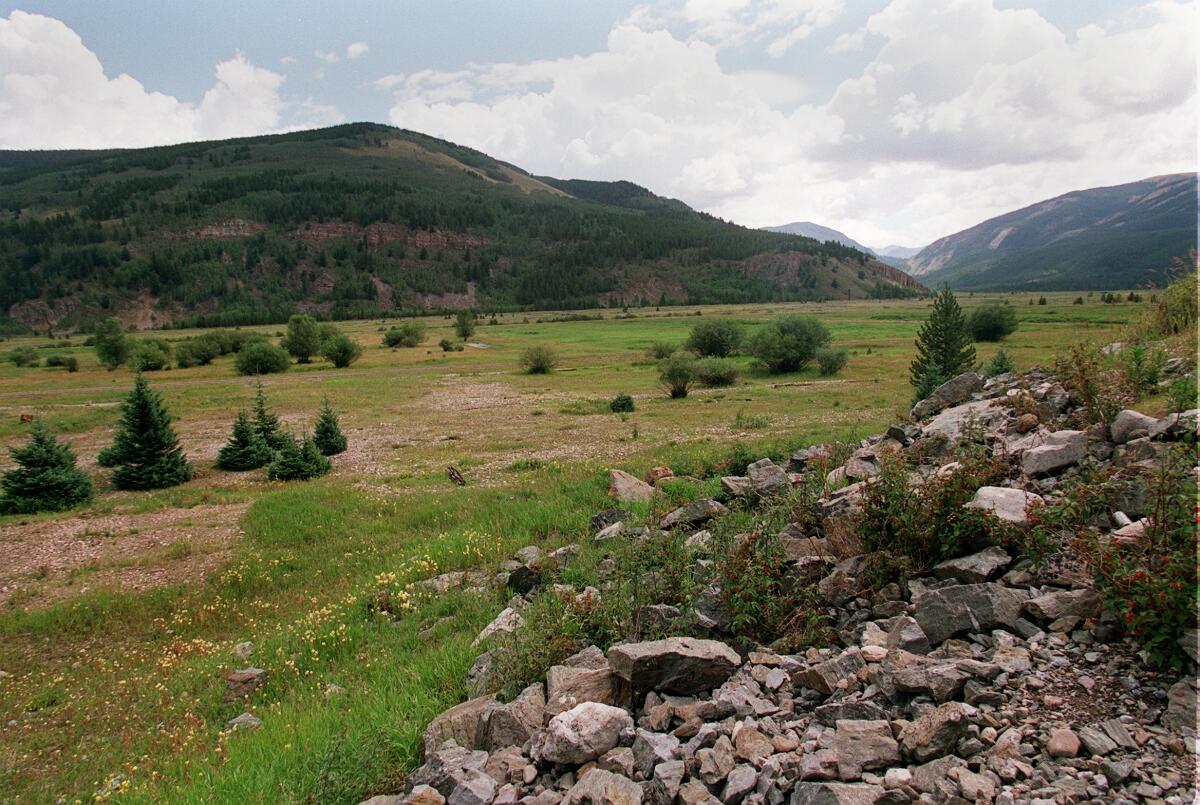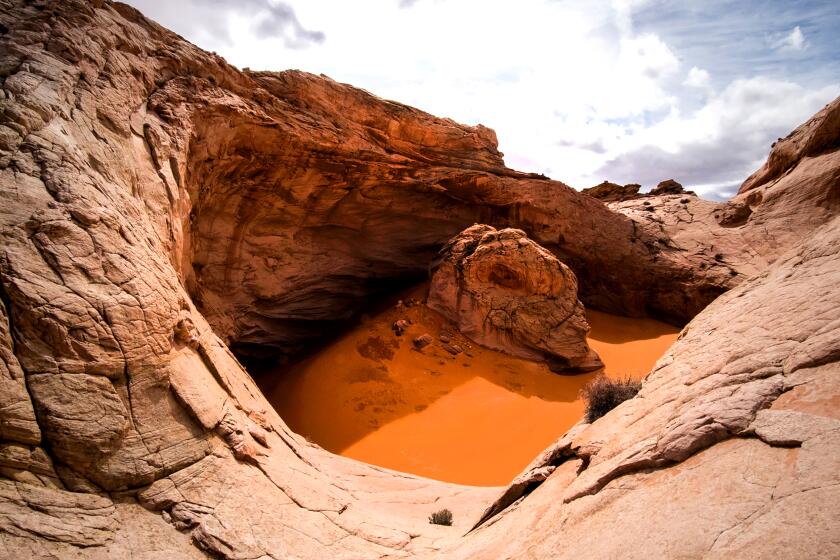Colorado gets a national monument to war’s potential to make ‘a better peace’

- Share via
On Wednesday, during a trip West, President Biden plans to name Camp Hale, near Leadville, Colo., our newest national monument (or perhaps our first-ever national historic landscape). Biden’s arrival at the site would make him the first president in more than a century to make an official visit to the heart of the Rocky Mountains and for an unprecedented occasion: a monument to the waging of peace.
In the United States, we make sacred many places touched by war. Pearl Harbor is a national memorial. Gettysburg is a national military park. Antietam, a national battlefield. Little Bighorn, a national monument. We preserve the awfulness of war so we never forget the cost.
But Camp Hale, born in World War II, pushes past that pain to show us what can be done when war ends. This special place will provide hope, not just to America and Americans, but to those now defending their homes in Ukraine and elsewhere. It stands for the good that can be found on the other side of fire and ruin.
The proposed legislation the president looks set to endorse would set aside at least 28,000 acres centered on the Pando Valley and straddling the Continental Divide at elevations ranging from 9,200 feet to 11,700. The key feature of the area, currently under Forest Service control, is its tranquility, “where the sky is the size of forever and the flowers are the size of a millisecond,” in the words of Ann Zwinger and Beatrice Willard’s book “The Land Above the Trees.”
President Biden has restored two sprawling national monuments in Utah, reversing a decision by President Trump that had opened some lands for mining and development.
It was here in 1942 the U.S. Army built Camp Hale. The war in Europe meant American soldiers could possibly fight in the Alps, in harsh high-elevation, cold-weather terrain. The Army was completely unprepared for such combat. Camp Hale (called Camp Hell by its original occupants), cost $30 million (about $480 million today) to build. It housed 16,000 troops from all over the United States, 4,000 mules and 200 women of the Women’s Army Corps. The unit was designated the 10th Mountain Division.
In Pando Valley now, you can still see remnants of the training facilities. A 50-bunker complex to the east, covered in prairie dog holes and caterpillars, full of smashed beer bottles and glass. Some gravel roads remain: B Street, D Street and Hospital Avenue. Signage points to the rock face where the 10th Mountain Division learned to climb.
After years of tough training, the Tenth was finally sent to northern Italy in early 1945. The Allies had failed several times to punch through the Gothic Line, a heavily fortified Nazi position in the Apennine Mountains. (Florence, to the south, had been taken by the Allies; Bologna was still Nazi-occupied and lay to the north.) The Camp Hale troops were the Allied spearhead to break the Gothic Line.
The men of the Tenth fought their way through a night assault up Riva Ridge, their piton hammers covered in cloth to silence their ascent up a 2,000-foot granite wall. (For “Game of Thrones” fans, this was a real-life version of the Wildling assault on the Wall.) They were like goldfish fighting their way up the side of a fishbowl, essentially the worst-case tactical scenario. But they did it, and went on to capture Mt. Belvedere and pierce the Nazi defensive line. The Allies pushed into the Po Valley, then on to the Austrian border, and put pressure on the Nazis from the south to help end the war.
It came at a terrible cost. A thousand dead and more than 3,000 wounded, nearly 30% of the Tenth’s fighting strength. Those who survived had every reason to resent every moment of their time in combat.
But they didn’t. They looked forward. They came back and built big bridges from war to peace for all of us to enjoy, using what they learned at Camp Hale and experienced in battle.
A new management plan for Grand Staircase-Escalante is due in 2024. It must incorporate Indigenous communities, focus on climate resilience and prioritize the survival of critical species and habitats.
Members of the 10th Mountain Division founded Vail, in Colorado (and 61 other ski resorts, according to a 1996 documentary), the National Outdoor Leadership School in Wyoming, the National Ski Patrol and the Wilderness Education Assn. One, David Brower, became the first executive director of the Sierra Club, and others were Olympians, outdoorsmen and ski instructors. When Edmund Hillary summitted Mt. Everest, he was using lightweight gear made by Gerry, a company founded by Gerry Cunningham of the 10th, who’s credited with inventing the down-filled jacket, not to mention the first backpack kiddie carrier.
Here’s another noteworthy Camp Hale name. Bill Bowerman. An Oregonian, in Italy he was promoted to major and earned a Silver Star and four Bronze Stars. After the war, he went back to Oregon, where he was one of the winningest running coaches that ever lived and co-founded Nike with his friend Phil Knight.
But in a life of coaching and business success, it was arguably in tragedy that Bowerman distinguished himself the most. Nearly three decades after the war, in 1972, Bowerman led the U.S. track team to the Olympics in Munich. When terrorists targeted Israelis at the Games, Bowerman safeguarded one Israeli athlete and calmly called U.S. Marines to protect his team’s Jewish Americans.
After the massacre, in which 11 Israeli coaches and athletes were killed, Bowerman called a team meeting. As recounted in a biography of Bowerman by Kenny Moore, one member, who did not want to continue competing, challenged the coach in front of the team: “If you throw a party and a gunman comes in and murders a dozen guests, you don’t break out another keg and go on with the party.”
Bowerman replied, “This is no party. This is [our] great moral advance. This is our answer to war.”
That spirit lives at Camp Hale. If war’s purpose, as a military strategist once said, “is to make a better peace,” then these are the ones who made it, and Camp Hale is where it was forged. A national monument is the least we can do.
Lt. Col. ML Cavanaugh, U.S. Army, is a Coloradan and a senior fellow with the Modern War Institute at West Point. @mlcavanaugh
More to Read
A cure for the common opinion
Get thought-provoking perspectives with our weekly newsletter.
You may occasionally receive promotional content from the Los Angeles Times.











